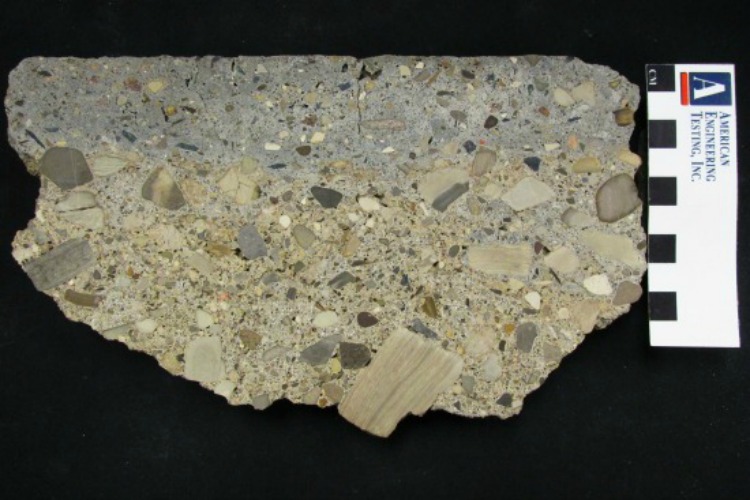The concrete pavement on Court Avenue, in Bellefontaine, Ohio was installed in 1893 as part of a project to pave all four streets surrounding the Court House of this small central Ohio town. The project was a gamble – this was the first-ever use of concrete on a U.S. roadway…
American Engineering Testing (AET) was contracted by the American Concrete Paving Association (ACPA) to investigate a concrete sample (shown above) from Court Avenue in preparation for a 125th anniversary celebration of this pavement. The longevity of the pavement, which is still in service, is a testament to the material’s durability, so the ACPA felt it warranted an in-depth study.
The AET study involved several collaborating parties, from both the private and academic sectors, and included physical, chemical, and petrographic analysis of the sample to better understand the 125-year-old pavement’s durability and longevity.
What do we know about this historic concrete’s production?
Similar to modern-day concrete, Bellefontaine’s Court Avenue concrete was produced from a mixture of aggregate and a cement powder that reacted with water to harden and bind the mixture together. Historic accounts documented that the concrete mixing was done in small batches. The sand, stone, and cement were mixed with water by hand and tamped into 5-foot square forms with tar paper placed between each slab. The pavement surface was tined (to help with horseshoe traction), covered with a layer of wet sand, and left to cure for one week.
Physical examination and petrographic evaluation reveals more production details
The concrete sample delivered to the AET Petrography and Chemistry Lab measured 12 inches across and was 6-8 inches thick, however a fractured bottom surface suggested that it didn’t represent the full thickness of the original pavement. The sample we received was sawed into several slabs for the laboratory analysis.
Aggregate characteristics
Upon examination of the sample, we could see right away that the pavement owes some of its longevity to a ‘two-lift’ design formed by placement of a base layer of concrete made with large aggregate, followed by the addition of an upper layer of concrete made with smaller aggregate – what is now known as granitoid-type construction. The top “wear” layer of the sample contained a mixture of natural ‘pea gravel’ and small angular rocks, similar to the shape and size used in modern-day concrete installations where the greatest compressive strengths are needed.
Water to cement ratio
The color of hardened concrete is an indicator of whether a cement paste was thick or thin when wet — a result of the ratio of water to cement used in the mix. (Concrete consistency is determined by “slump tests” of the wet concrete in modern-day construction.) The yellowish-gray to very pale orange color of the lower layer indicates a thin paste, which results in softer concrete. The upper “wear course”, however, is a darker gray color, indicating it was a very thick paste, resulting in hard, durable concrete. Petrographic and physical testing of the concrete paste confirmed our observations.
Air void analysis
Air bubbles become trapped within concrete during preparation and installation, resulting in small voids in the hardened concrete. When temperatures drop, these microscopic air pockets provide room for water to expand as it freezes, reducing internal pressure that could cause damage. An air void analysis of both concrete layers showed that they actually meet modern recommendations for freeze/thaw durability. The base layer also contained larger irregular-shaped voids, typically seen as a result of incomplete tamping of the concrete mixture. These air pockets formed a ‘honeycomb’ appearance in some places, which would promote drainage of rainwater and snow melt.
Chemical examination reveals portland cement composition
Concrete hardens when mixed with water because the cement goes through a series of chemical reactions, leaving behind predictable minerals that grow together and interlock to give cement its strength. Scanning electron microscopy and energy dispersive spectroscopy results revealed that the cement in the Court Avenue concrete sample can be classified as a portland cement. The process for producing Portland cement had only recently been introduced to the U.S. from England and Germany. Portland cement is the most durable type of cement used for roadways — even today. In 1893, when the Bellefontaine’s Court Avenue was paved, America’s roadways were either unpaved or, in larger cities, lined with brick or cobblestones set in sand or mortar.
The conclusion of our study
So, to what can we attribute the remarkably long service life of this concrete, which holds a place on the National Register of Historic Places and as a National Historic Civil Engineering Landmark?
We conclude that the Court Avenue pavement owes its longevity to a two-lift design with a durable upper layer, sufficient incorporation of air during mixing, and the use of portland cement to provide overall concrete strength. Interestingly, it seems that the incorporation of air in the mixture was likely incidental, as the concrete was mixed by hand without modern air-entraining techniques.
It’s remarkable to see that this historic pavement, which was produced by hand in small batches, is very close to modern concrete in design and composition.
To read more about the historic Bellefontaine concrete and the technical details of the AET study, please download a copy of the paper prepared by Mr. Lemcke (below) for the 69th Highway Geology Symposium, September 2018: Laboratory Investigations of the Oldest Concrete Pavement in America – Applied Geology in Civil Engineering by Blake Lemcke, 2018.
LaboratoryInvest-OldestConcretePavementAmerica_Lemcke_2018.pdf
Petrography proved to be a powerful and beneficial tool for understanding the properties and overall success of this historic concrete. AET is often contracted for petrographic analysis of modern concretes to determine the cause(s) of performance issues or to aid in condition assessments, as well as for quality control and material screening purposes. Contact the AET Petrography and Chemistry Lab for more information.
Blake Lemcke, PG, is a senior petrographer and geologist in our Petrography and Chemistry Department and can be reached at blemcke@amengtest.com


